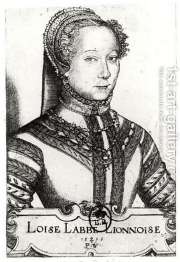|
Биография Louise Labé
Louise Labé, (c. 1520 or 1522, Lyon - April 25, 1566, Parcieux-en-Dombes), also identified as La Belle Cordière, was a female French poet of the Renaissance, born at Lyon, the daughter of a rich ropemaker, Pierre Charly, and his second wife, Etiennette Roybet. A recent book has argued that the poetry asscribed to her was a feminist creation of a number of French male poets of the Renaissance (see below).
Both her father and her stepmother Antoinette Taillard (whom Pierre Charly married following Etiennette Roybet's death in 1523) were illiterate, but Labé received an education in Latin, Italian and music, perhaps in a convent school.
At the siege of Perpignan, or in a tournament there, she is said to have dressed in male clothing and fought on horseback in the ranks of the Dauphin, afterwards Henry II.
Between 1543 and 1545 she married Ennemond Perrin, a ropemaker.
She became active in a circle of Lyonnais poets and humanists grouped around the figure of Maurice Scève. Her Œuvres were printed in 1555, by the renowned Lyonnais printer Jean de Tournes.
In addition to her own writings, the volume contained twenty-four poems in her honor, authored by her male contemporaries and entitled Escriz de divers poetes, a la louenge de Louize Labe Lionnoize.
The authors of these praise poems (not all of whom can be reliably identified) include Maurice Scève, Pontus de Tyard, Claude de Taillemont, Clement Marot, Olivier de Magny, Jean-Antoine de Baif, Mellin de Saint-Gelais, Antoine du Moulin, and Antoine Fumee.
Her Œuvres include two prose works: a feminist preface, urging women to write, that is dedicated to a young noblewoman of Lyon, Clemence de Bourges; and a dramatic allegory in prose entitled Debat de Folie et d'Amour, which draws on Erasmus' Praise of Folly.
Her poetry consists of three elegies in the style of the Heroides of Ovid, and twenty-four sonnets that draw on the traditions of Neoplatonism and Petrarchism.
The Debat, the most popular of her works in the sixteenth century, inspired one of the fables of Jean de la Fontaine and was translated into English by Robert Greene in 1584.
The sonnets, remarkable for their frank eroticism, have been her most famous works following the early modern period, and were translated into German by Rainer Maria Rilke.
|





